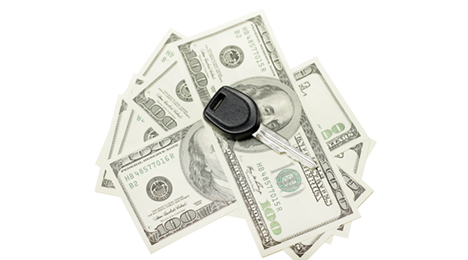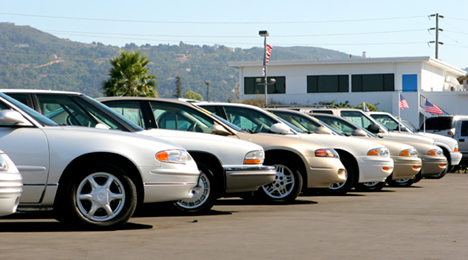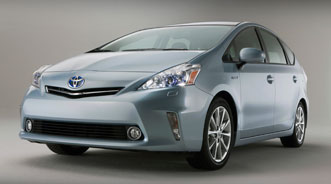This month’s projected new-vehicle sales activity is likely to push lenders’ portfolio total higher — along with elongated terms connected with those contracts.
J.D. Power estimated that consumers will spend $33.5 billion purchasing new vehicles this month, a historic record level for the month of April. The previous April high was $30.5 billion in 2005.
“The April 2014 consumer spending reflects a combination of record average transaction prices — which, at nearly $29,800, surpasses the previous April high of $28,754 in 2013 — and strong retail sales volume,” said John Humphrey, senior vice president of the global automotive practice at J.D. Power.
J.D. Power’s data shows changes in who is buying new vehicles and how they are paying for them.
Buyers 35 years of age and younger are expected to account for 25 percent of new-vehicle retail sales in April, marking a rebound to pre-recession levels.
Additionally, J.D. Power indicated nearly one-third of new vehicles sold in April will be financed with a loan of 72 months or longer, with younger buyers in particular using the longer term loans to manage their monthly payments.
“Among buyers who are 35-years old and younger, 44 percent opt for 72-month or longer loans, while only 25 percent of those who are 55 years and older use an extended loan term,” Humphrey said.
J.D. Power projected that retail light-vehicle sales in April are expected to come in at 1.1 million units, 5 percent higher than in April of last year.
The seasonally adjusted annualized selling rate (SAAR) is expected to be 13.3 million units, more than 700,000 units higher than a year ago, according to J.D. Power.
Meanwhile, Edmunds.com is anticipating a robust new-vehicle sales performance for April.
Edmunds.com predicted that that 1,401,606 new cars and trucks will be sold in the U.S. in April for an estimated SAAR of 16.2 million. The projected sales will be an 8.7 percent decrease from March, but a 9.1 percent increase from April of last year.
The site’s forecast anticipates that the auto industry will enjoy its best April performance since franchised dealers sold 1,444,587 vehicles in April 2006.
“April’s numbers suggest that car shoppers are still motivated to buy new cars, erasing any doubts raised by lackluster sales at the beginning of the year,” Edmunds.com senior analyst Jessica Caldwell said. “The sales performance the last two months is more in line with what we projected for 2014, and there’s every reason to believe that car shoppers will continue to keep this pace.”
The National Credit Union Foundation, in partnership with Filene Research Institute, highlighted that 14 credit unions across the country are participating in a product incubator for non-prime auto loans.
The following credit unions will be testing the non-prime auto loan product:
—CALCOE FCU in Yakima, Wash.
—Cy-Fair FCU in Houston
—Denver Community CU in Denver
—EECU in Fort Worth, Texas
—Freedom First CU in Roanoke, Va.
—Laramie Plains Community FCU in Laramie, Wyo.
—Missoula FCU in Missoula, Mont.
—SchoolsFirst FCU in Santa Ana, Calif.
—Seasons CU in Middletown, Conn.
—Shreveport FCU in Shreveport, La.
—Soo Coop CU in Sault Ste Marie, Mich.
—Summit CU in Madison, Wis.
—University CU in Austin, Texas
—US FCU in Burnsville, Minn.
These non-prime auto loans are one of five products in the Filene Research Institute’s accessible financial services incubator funded by the Ford Foundation.
“Credit unions have a long history as being the proving ground for consumer centric, innovative financial products,” said Cynthia Campbell, director of innovation labs at Filene. “And partnering with the NCUF to test the viability of Non-Prime Auto Loans with mainstream financial institutions was a natural fit since their experience in working with low-to-moderate income consumers is extensive.”
NCUF noted that 88 percent of Americans drive to work. Without a vehicle, NCUF executive director Gigi Hyland acknowledged that options for work, food, childcare and healthcare become limited.
Hyland insisted economic mobility is strengthened through the mobility that comes with affordable, reliable wheels, and this product increases access to affordable vehicle loans to those who have credit challenges.
“Estimates say that families can increase their income by as much as 25 percent with access to reliable transportation,” Hyland said.
“We’re excited to work with not only Filene on this project but also such a wide array of credit unions across the country to give affordable, safe and reliable used cars to those that need them most,” she went on to say.
Moody’s sees finance companies easing off the subprime vehicle loan accelerator, but analysts stopped short of saying that lenders are ready to hit the brakes on originations to consumers with damaged credit histories.
According to a new report from Moody’s, U.S. subprime auto lenders are exercising more caution in granting loans to increasingly risky borrowers, although some data lead Moody's to conclude that a major slowdown in subprime lending is not in the offing.
The report titled, “U.S. Subprime Auto Lenders Somewhat More Cautious,” is based on an analysis of the latest data from Experian.
Moody’s vice president and senior analyst Peter McNally explained that one factor pointing to increasing caution among lenders was improved borrower credit scores for used auto loans in the fourth quarter 2013, the first year-over-year improvement since 2010.
Another factor McNally mentioned is slower growth in the shares of lending in the subprime space held by banks, credit unions, and captive finance companies.
“Declining competition from non-traditional subprime lenders puts less pressure on independent finance companies to lend to weaker borrowers to maintain their lending volumes” McNally said.
“If lenders maintain this caution, loan losses among newer loans could stabilize,” he continued.
McNally also pointed out that rising interest rates on subprime loans also indicate that lenders are becoming more cautious. Previously, APRs were falling despite the decline in credit, suggesting that competition was strong enough for lenders to leave themselves uncompensated for rising risk levels.
“However, rising loan-to-values and loan terms suggest that lenders are still willing to take on increasing risk,” McNally said. “So we don’t anticipate a major slowdown in subprime lending.”
The report also indicated some lenders could also be more hesitant given the deteriorating performance of recent subprime originations. Analysts cited Experian data that showed delinquency rates in recent originations by finance companies, which grant a high share of their loans to less-than-prime borrowers, are increasing.
Loans originated in 2013 had the highest delinquencies since those originated in 2008, according to Experian.
Moody's expects that new loan volumes will remain high, at least through 2015, because market conditions remain favorable for increased lending.
“The improving labor market, along with pent-up demand in the auto industry, will generate new customers. At the same time, persistently low interest rates, which give lenders low cost of funds, will entice lenders to keep making loans,” McNally said.
As its amount of new contracts purchased climbed, Consumer Portfolio Services generated a 75-percent increase in earnings per share during the first quarter.
CPS reported that its Q1 earnings totaled $6.7 million, or $0.21 per diluted share. Those figures are up from the company’s net income of $3.8 million, or $0.12 per diluted share, in the first quarter of 2013.
Officials indicated revenues for the first quarter came in at $68.1 million, an increase of $13.5 million or 24.8 percent, compared to $54.6 million for the first quarter of 2013.
Meanwhile, CPS acknowledged its total first-quarter operating expenses rose $8.3 million or 17.3 percent to $56.4 million, up from $48.1 a year earlier.
The company’s first-quarter pretax income soared to $11.8 million, compared to pretax income of $6.5 million in the first quarter of 2013, an increase of 80 percent.
During the first quarter, CPS purchased $189.9 million of new contracts compared to $173.4 million during the fourth quarter of 2013 and $180.1 million during the first quarter of 2013.
The company’s managed receivables totaled $1.295 billion as of March 31, an increase from $1.231 billion as of Dec. 31 and $968.5 million as of March 31 of last year.
Looking at other performance metrics, CPS noted that its annualized net charge-offs for the first quarter were 5.54 percent of the average owned portfolio as compared to 4.23 percent for the first quarter of last year.
Officials said their delinquencies greater than 30 days (including repossession inventory) represented 6.33 percent of the total owned portfolio as of March 31, as compared to 4.16 percent as of the same date last year.
As previously reported, CPS closed its first term securitization transaction of the year during March and the 12th transaction since April 2011.
In the senior subordinate structure, a special purpose subsidiary sold five tranches of asset-backed notes totaling $180.0 million. The notes are secured by automobile receivables purchased by CPS and have a weighted average effective coupon of approximately 2.51 percent. The transaction has initial credit enhancement consisting of a cash deposit equal to 1.00 percent of the original receivable pool balance. The final enhancement level requires accelerated payment of principal on the notes to reach overcollateralization of 5.00 percent of the then-outstanding receivable pool balance.
“The first quarter of 2014 was a good start to the year for us,” CPS chairman and chief executive officer Brad Bradley said. “We experienced a nice increase in our new contract purchases over the fourth quarter of 2013 and achieved continued earnings growth.
“In addition, we hit a milestone in one of our corporate objectives by fully repaying our senior, secured corporate debt,” Bradley continued. “This demonstrates our continued diligence in deleveraging our balance sheet. As we have discussed in the past, we feel this will position us well to navigate a wide variety of operating landscapes.”
With only about a month of data and originations in the portfolio, CarMax leaders are still waiting for more seasoning and growth to occur before making a significant evaluation of their new subprime financing initiative they launched at the beginning of the year.
According to its report when CarMax closed the fourth quarter of its fiscal year on Feb. 28, the company originated $9.1 million worth of contracts through CarMax Auto Finance that typically would be financed by its third-party subprime providers. CarMax is looking to originate approximately $70 million of loans during the testing phase.
CarMax indicated third-party subprime financing providers accounted for about 17 percent of the company’s sales in the Q4.
“That’s flat year-over-year which represent some moderation versus the first three quarters where we saw an increase to 5 points in Q1 and 3 points in each of Q2 and Q3,” CarMax senior vice president and chief financial officer Tom Reedy said in a conference call with investment analysts.
“As we said in the press release, we launched our test in January to learn more about originating and servicing customers who would typically be funded by our subprime providers. During the quarter, we originated $9 million. It’s very early in this process, and we will share information and learnings once it is appropriate,” Reedy continued in the call transcript posted by SeekingAlpha.com.
The subprime initiative helped CarMax Auto Finance’s four-quarter income climb 6 percent year-over-year to $80.8 million. The company said the gain also was driven by an increase in auto loan receivables, largely offset by a lower total interest margin.
CAF’s average managed receivables grew 23 percent to $7.04 billion, as the finance company’s loan originations have grown in recent years.
Officials added the total interest margin, which reflects the spread between interest and fees charged to consumers and the company’s funding costs, declined to 6.6 percent of average managed receivables in the current quarter from 7.2 percent in last year’s fourth quarter.
Wall Street observers still pushed CarMax management to determine whether its new subprime program started in response to a pullback by third-party providers, a sentiment chief executive officer Tom Folliard hinted at after the close of the company’s fiscal third quarter.
“We can’t control what our subprime providers do or any of our lenders for that matter since they have all their own models,” Folliard said. “They see these loan applications after they’ve been declined by everybody else. They’re terrific partners they’ve been a great add to our business and they allow us to offer credit terms to a full suite of credit profile that enter our store each and every day.
“How they’ll move going forward, it’s very difficult to say but all we were talking about at the end of the third quarter was we didn’t expect to see continued expansion as it relates to the percent of sales,” he went on to say.
CNW Research reported that March used-vehicle sales rebounded significantly versus the previous month in part to a surge of subprime buyers during the peak of tax season.
Monthly used-vehicle sales surpassed 3 million units for the first time this year as CNW computed the March figure came in at 3.088 million. That figure represents a gain of more than 50 percent from February’s sales amount, which was 2.055 million.
“And it wasn’t just in the franchised channel. Independents and Casual sales also showed significant 50 percent increases versus February,” CNW president Art Spinella said.
The firm determined franchised dealerships sold more than 1 million used vehicles in a month for the first time in 2014 as these stores turned 1.096 million units. Sales at independent dealerships also topped the 1-million mark. Private party transactions came in just below that threshold as the firm put the total at 985,316.
Goosing those figures was the amount of subprime buyers who made a used-vehicle purchase thanks to an influx of tax-refund cash.
CNW indicated the number of subprime buyers in March rose 17 percent versus a year ago and soared 57 percent above the February figure.
Meanwhile, the firm noted that sales to consumers with FICO scores below 550 spiked 51.6 percent month-over-month. Sales to those deep subprime buyers also jumped 11.8 percent in March versus the same month a year earlier.
All told, CNW said about 3 percent more units were financed in March versus a year ago.
As an industry on a year-over-year basis, CNW determined that used-vehicle climbed 2.7 percent with franchised dealer sales units up 1 percent, independent dealer sales up 4.8 percent and private party transactions gaining 2.55 percent.
“But the good news doesn’t stop there,” Spinella said. “Franchised transaction prices rose a healthy 10.8 percent on the back of growing certified pre-owned units.
“Independents also saw an increase in transaction prices but at a more modest 1.52 percent versus year ago while private party sucked a lot of newer (15-plus year old) models off the market and was able to make a 5 percent increase in transaction prices,” he continued.
Spinella pointed out that the used-vehicle industry generated these sales numbers with 13 percent fewer used shoppers searching lots versus year ago, “indicating the pent-up demand log jam may well be breaking.”
Consumers from up and down the credit spectrum have been able to secure vehicle financing relatively easily for the past 12 months, leading a resurgence in originations and sales of both used and new vehicles.
While that financing faucet is currently flowing strong, analysts from NADA Used Car Guide contend that stream might slacken a bit during the second half of the year.
“Much has been made of the role of pent-up demand in the automotive market’s recovery over the past few years, but less discussed has been the large role credit has played in its resurgence,” analysts said in the “2014 Used Vehicle Price Forecast” special report from NADA UCG
Per data from the Federal Reserve, the report mentioned new-model auto loan interest rates were at their lowest level in at least 40 years in 2013. Analysts also noted that after years of recession-led deleveraging, household debt as a percent of income fell to levels last observed in the early 1990s.
“So not only were interest rates keeping the cost of borrowing very low, the anxiety of taking on more debt was greatly reduced,” analysts said.
NADA UCG reiterated that lender willingness to extend credit has also been very high.
At $850 billion, outstanding auto loan debt exceeded pre-recession levels in the third quarter last year according to the Federal Reserve Bank of New York. Meanwhile Experian Automotive data shows that the below-prime share of used-vehicle loans averaged nearly 56.7 percent through Q3 2013 — up from 2012’s like-period average of 55.9 percent and essentially equal to 2007’s three-quarter average of 56.6 percent.
Additional examples of lender eagerness culled from Experian data include progressively higher loan-to-value ratios and the willingness to extend loan terms.
The average length of new-vehicle loan terms grew from 63 months at the end of 2010 to 65 months through the third quarter of 2013, while used-vehicle terms grew from 58 to 61 months over the same period.
Analysts went on to highlighted the extraordinary conditions of the past few years are also clearly evident in NADA UCG’s credit composite, which reflects credit conditions based on interest rates, the ability and ease in obtaining credit, and consumer comfort with taking on additional debt.
Last year, the composite portrayed credit conditions that were at their most positive level for used vehicle prices in more than 20 years. And by the report’s estimation, credit has added 5 percent to 6 percent to used-vehicle prices since 2010.
“Considering the strength of today’s credit environment relative to years past, we believe conditions will begin to become slightly less favorable toward the latter half of the year as the market transitions from a uniquely positive period to one more in line with historic norms,” analysts said.
“And while the prevailing sentiment is that rates will stay relatively flat for stronger credit tiers, they should begin to inch up for lower-tier borrowers as lenders react to the heightened level of risk presented by the growing below-prime share of loan portfolios,” they went on to say.
The latest data from Equifax showed the number of subprime auto financing originations climbed for the fifth year in a row, surpassing 7 million contracts for the first time since 2007.
Analysts indicated the number of subprime contracts for 2013 came in at 7.3 million, up from 6.6 million a year earlier. Back in 2007, the subprime origination amount was 7.8 million, off slightly from the recent high of 8.1 million set in 2006.
“In 2013, the independent auto finance companies, the non-bank, non-captive, non-credit union companies, really led the way,” said Lou Loquasto, Equifax’s auto finance vertical leader.
Loquasto explained to SubPrime Auto Finance News what is providing the fuel for this continued subprime resurgence.
“We’ve seen new companies come into the market and private equity investing a lot into the market. That’s reflecting in the data,” he said.
“It’s because that’s where the highest yields are. These private equity companies can invest in anything they want. When they decide to invest in auto, it’s always in subprime auto because they’re chasing the highest yields,” Loquasto went on to say.
Equifax most recent data also showed that finance companies are putting more faith in subprime consumers since the loan cap for these contracts ended up above $18,000 in December — the first time that’s happened since December 2006. The cap stood at $18,120 in December 2013, marking a significant five-year rise since bottoming out at $14,753.
Loquasto insisted that climbing cap number is a “sign of health,” in the subprime auto finance sector. He noted that as applicants come from deeper into the credit spectrum, finance companies often consider a credit score as a smaller piece of the decision to book the deal and for what terms.
“What’s happening in the subprime market, the lenders are being more sophisticated and precise as to what subprime borrowers they make loans to,” Loquasto said. “They’re using a lot of other data like income data, employment data and length of time on their job and other alternative data.
“They might be lending more money to that 540 FICO score borrower, but they’re doing it because they know that this guy does make this much in verifiable income a month and they have been on their job for say, eight years. And the alternative data is showing they’re paying their cell phone bill, their cable bill and other utilities, data that a lot of these lenders didn’t have access to before,” he continued.
“It’s more of a reflection of auto lenders using more tools and being able to be more sophisticated in how they lend to that segment. It’s more than just a credit score,” Loquasto added.
With more tools at their disposal, Loquasto is confident subprime originations will stay on their current trajectory.
“We’re thinking it will continue to grow but maybe not at the pace that it’s been growing. We’ll probably continue to see a very methodical increase, eventually getting back to the 2006, 2007 levels,” Loquasto said.
A former senior vice president of Nicholas Financial is looking to duplicate the same success he enjoyed previously now that he is overseeing a North Carolina-based operation fueled by a merchant banking firm.
Douglas Marohn now is chief executive officer at Metrolina Credit Co., which recently acquired locations in Charlotte and Concord, N.C., to go along with the previous purchase of a location in High Point, N.C., by ML Credit Group, an organization affiliated with merchant banking firm Comstock Capital & Advisory Group.
As an indirect, subprime lender, Metrolina provides vehicle financing solutions for both franchised and independent dealers in North Carolina, but Marohn has his eyes on spreading well beyond the Carolinas.
“Metrolina has operated in the North Carolina market for over 20 years and has an excellent reputation for being an honest, straightforward lender, ready to provide financing solutions for its dealer partners. I am excited to perpetuate the brand that Metrolina has established as we expand within North Carolina and additional markets,” Marohn said.
“We have an opportunity to do exactly what I did at Nicholas and grow slowly but methodically,” continued Marohn, referencing Ohio, Florida, Georgia and Tennessee as possible destinations as well as “any state that has favorable laws and rates for our type of business.”
First Orders of Business
Since coming on board earlier this year, Marohn explained to SubPrime Auto Finance News some of the first chores he needed to accomplish.
First, the company had to streamline processes that had been irregular since nearly eight families composed the previous ownership and operated each branch differently.
“Job one was to create identifiable brand identity and brand equity,” Marohn said. “The previous owners, for all the good things they did, there was a splintered, fractional ownership. Our High Point brach operated one way. The Charlotte branch operated another way. The Concord branch operated another. There were a lot of similarities in the way they did business, but there were also some very significant differences whether it was the type of deals they financed or the structure they brought to the table or which products they sold.
“My job right now is to have a universal approach,” he continued. “Metrolina in High Point should be operating the exact same way as Metrolina in Concord or Charlotte to our borrowing customer as well as our dealership customer. Our programs should be the same. Our underwriting should be the same. The level of service and commitment to excellence should be exactly the same.”
Next, Marohn is out to expand Metrolina’s market share and amount of receivables. He explained the company previously was primarily a recourse lender. Metrolina currently has about $12 million in receivables through 2,500 customers.
Marohn said, “20 years ago only a handful of dealerships did subprime. Now they all do. And because Metrolina had plenty of business through their core dealerships, they hadn’t needed to or had the appetite to expand their business in the marketplace.
“We’ve got money to lend,” he continued, referencing the financial backing the company has through First Tennessee Bank. “Nothing is easy, but there is a lot of opportunity out there before we even expand our footprint of branches to expand our business in the markets we’re currently in.”
Underwriting Strategy
Marohn is upbeat about the potential pool of customers Metrolina can tap to build its portfolio. He noted the company’s underwriting strategy isn’t much different than what might be utilized at Nicholas Financial or another subprime finance company.
“Like other successful companies in the true deep subprime space, we bring a common-sense approach,” he said. “There is no cookie-cutter scorecard. There is no credit scoring. We have those internal guidelines, of course, things that we look for when we underwrite a deal. But no one deal is ever the same.
“You can’t buy this paper on a slide rule. You can maybe do that in the high 500, low 600 beacon score ranges when you have little more predictability with the FICO scores and you’re buying a little more in volume,” Marohn went on to say, adding that Metrolina is open to making deals with customers who have credit scores in the 400s.
Why would the company delve that deep into the credit spectrum?
“We are looking at the strength and stability of the customer and their ability to repay the loan based off their income and capacity,” Marohn said. “Then we look at their credit to try to find the best deal structure. We believe that almost any applicant can be approved and a deal can be structured in a positive way. It may not be exactly what the customer is looking to buy. It may not be exactly what the dealer is looking to put together. But we can find a way to approve almost any customer and we do so because we investigate the deal up front.
“We interview the customer prior to decisioning the deal,” he continued. “We know that customer better than usually the dealer will know that customer. We can put together a deal that matches that particular customer’s situation. I always say we don’t sell price, but we do sell pricing. We’re not going to be the highest advance or the lowest rate or the smallest discount, but we will have the structure that best meets that customer’s situation and provides them with the best opportunity to succeed and complete the loan, which is best for everyone. The customer doesn’t have any negative impact. We don’t have any losses, and the dealership sells a car and most likely has a repeat customer.”
Long-Term Objectives
Marohn spent 13 years at Nicholas Financial, leaving in 2011. During that span, he helped to grow Nicholas from a company that had 15 braches working solely with independent dealers to an operation that had more than 70 locations in 15 states where 60 percent of the dealer network was composed for franchised stores.
“The independent dealer has been the core of subprime business and the core of Metrolina, so we’re probably going to be focusing on that independent dealership but not exclusively,” Marohn said. “There’s a lot of great business to be had from the franchise dealerships and we want to be more and more a part of that as we grow.”
Before the end of the year, Metrolina hopes to roll out branch locations in Raleigh, N.C., and Spartanburg, S.C.
“From there, we’ll expand to whatever market makes the most sense. We have no desire to stay in just North and South Carolina. We plan to expand to most every state that is conducive to our business,” Marohn said.
And with Marohn at the controls, Comstock Capital is confident Metrolina can achieve its objectives and more.
“We are extremely excited to partner with Mr. Marohn as we continue to expand the Metrolina platform in North Carolina,” Comstock managing director John Nagy said. “Mr. Marohn’s extensive experience in the indirect auto finance industry, particularly building best in class branch based operating models we believe well positions Metrolina for continued success as we expand the footprint.”
There now is a much larger pool of funds to underwrite contracts for Toyota’s most fuel-efficient vehicles.
Today, Toyota Financial Services issued what the company believes is the industry’s first-ever asset-backed green bond in the amount of $1.75 billion. Officials highlighted the offering was upsized from $1.25 billion to accommodate demand as institutional investors demonstrated strong interest in this inaugural clean transportation investment opportunity.
The company pointed out the green bond is the newest component of TFS’ broad-ranging funding program and serves to enhance Toyota’s green commitment.
Proceeds of the TFS green bond will be used to fund new retail finance contracts and lease contracts for Toyota and Lexus vehicles that meet specific criteria, including powertrain, fuel efficiency and emissions. There are currently nine vehicles in the Toyota and Lexus portfolio of green vehicles that qualify.
“Investors have enthusiastically welcomed the industry's first Green Bond from Toyota Financial Services as a sign of our company's commitment to environmentally friendly transportation,” TFS chief executive officer Mike Groff said.
“The green bond itself represents the innovation that TFS brings to the financial marketplace in creating asset-backed investments that reflect the values of our company. This, in turn, enables us to provide Toyota customers with attractive financing options for their vehicles,” Groff continued.
To develop the green bond, TFS worked closely with Citi, which has a long-standing relationship with TFS and shares its commitment to green innovation. Citi served as the structuring lead manager of the bond, and BofA Merrill Lynch and Morgan Stanley acted as joint-lead managers.
Officials reiterated their claim that the TFS green bond is the first of its kind in the industry and enhances Toyota’s leadership reputation for green innovation. Toyota currently offers hybrid editions in nearly all of its vehicle categories.
At the end of 2013, Toyota’s global sales of hybrids reached more than 6 million vehicles. The latest million-unit milestone was achieved in the fastest time yet for Toyota, taking just nine months.
Since the launch of the first Prius in 1997, officials determined Toyota’s hybrid vehicles have resulted in approximately 41 million fewer tons of carbon-dioxide emissions than would have been emitted by gas-powered vehicles of similar size and driving performance.
Tyler Dickson, global head of capital markets origination at Citi, said, “We see excellent investment opportunities for the growing interest among investors and consumers alike in environmentally friendly, energy efficient, clean transportation. The marketplace is eager for these investments and Citi is proud to work with Toyota to issue innovative deals like the TFS green bond.”
TFS will commit to use the proceeds of the Green Bond toward the purchase of retail finance contracts and lease contracts for Toyota and Lexus vehicles that meet high green standards as established by three criteria:
— Gas-electric hybrid or alternative fuel powertrain
— Minimum EPA estimated MPG (or MPG equivalent for alternative fuel vehicles) of 35 city / 35 highway
— California Low-Emission Vehicle II (LEV II) certification of super ultra-low emission vehicles (SULEVs) or higher, which would include partial zero emissions vehicles (PZEVs) and zero emissions vehicles (ZEVs)
Qualifying models from Toyota include: Prius, Prius c, Prius v, Prius Plug-in, Camry Hybrid, Avalon Hybrid, and RAV4 EV. From Lexus, qualifying vehicles are CT 200h and ES 300h.
For more information on TFS’ capital markets programs, visit www.toyotafinancial.com. For more information about Toyota’s commitment to the environment, visit www.toyota.com/about/environmentreport2013.












